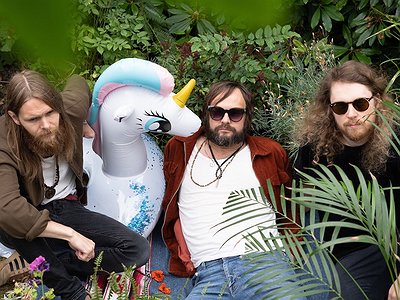Part 2
Take us through a day in your life, from a possible morning routine through to your work, please.
Sigbjørn: I have three kids so first thing in the morning I get them ready for school and kindergarten. Then kiss my wife and my oldest son goodbye on their way to work and school and walk my girls to kindergarden. Then I take a peaceful coffee and plan the day. Before I go to work I might head down to the gym and have work out on the gymnastic rings. Take a shower and head to Tou Scene where I work.
Tou Scene is this great cultural hub in this old brewing factory. At Tou there are multible venues, recording studios, a vinyl plant, dance- and art studios, bars and take-away restaurants. I run a little record label there so I might meet some an artist that I am working with and plan their next release.
Then head to over to the studio and rehearsal space we have at Tou and work on some ideas or a demo recording. Some days John and Øivind come by, if they have the day off from work, and lay down some tracks on a demo.
Could you describe your creative process on the basis of a piece, live performance or album that's particularly dear to you, please?
Øivind: I look at our creative process as a balance between two opposites. You have the one side that is instinctive and based on what connect with us emotionally. The primal feeling of melodies, beats and timbres that tingle your brain, give you goose bumps and make your body move.
And on the other side you have the analytical and critical side of the process: Breaking the individual parts down and making conscious decisions about how to structure and arrange the songs, and fill the arrangement with small drops of surprises.
My favorite songs of Nylenda are when we hit that balance. Not being too smart or “artsy” about the arrangement, and at the same time not being too repetitive and locked in a specific groove.
Listening can be both a solitary and a communal activity. Likewise, creating music can be private or collaborative. Can you talk about your preferences in this regard and how these constellations influence creative results?
We all work on our parts individually before we record our ideas collectively. We are very generous toward each other and invite new approaches or suggestions to make our own ideas better or more refined. It´s a good thing to let your partners contribute and shape your ideas.
For us it´s more creative to work collectively as opposed to just as individuals. We share all the song credits between us because the finished song is always the result of a very collective process.
How do your work and your creativity relate to the world and what is the role of music in society?
We are all political and socially alert individuals. We have strong beliefs and discuss politics, art, philosophy, and power regularly. Our music is political but not in a direct sense we would say. It´s more about an attitude than a statement.
Music deals with our most intimate and private states of being in this world. It shapes us and gives people a way of expressing themselves both by listening and performing. Sometimes music can bring large groups of individuals toward a shared belief and create powerful movements and enlightenment. It has the means to be a very powerful thing in our lives, but we don´t believe that it can bring peace or change nations on a large scale.
Art can be a way of dealing with the big topics in life: Life, loss, death, love, pain, and many more. In which way and on which occasions has music – both your own or that of others - contributed to your understanding of these questions?
Øivind: That’s a big one! It’s hard to point to one specific occasion. What’s special about music and art is that it can speak to me in a profound way, without me actually trying to analyse or make sense out of what a specific track or piece of art is trying to tell me. When music hits you, it can hit hard, and make you connect with what’s going on inside you.
I had that kind of feeling yesterday: I layed down in bed listened to Bendik Giskes track “Cruising”. A spine chilling 10 minute instrumental track. That song took me for an emotional ride. It’s like he’s telling you some deep truths about life using only the saxophone.
How do you see the connection between music and science and what can these two fields reveal about each other?
Sigbjørn: Music and science are closely related. Both use mathematical principles and logic, blended with creative thinking and inspiration to arrive at conclusions that are both enlightening and inspirational.
Science can reveal the individual parts that make up the music, and break a sound into elements of pitch, rhythm and tempo. But music is not just an arranged set of noises pleasant to the ear. A purely scientific explanation of music would miss the point. Music is emotion and a pure form of communication that transcend languages and touches us at the core of being human.
Music is an inexplicable manifestation that is uniquely human.
Creativity can reach many different corners of our lives. Do you feel as though writing or performing a piece of music is inherently different from something like making a great cup of coffee? What do you express through music that you couldn't or wouldn't in more 'mundane' tasks?
John: By writing and performing music it allows us to get into a state we like to call “flow”. In this state time and space cease to exist, almost like a trance. You get extremely focused but at the same time lucid, this gives us potentially a euphoric experience.
To be inside our music when performing brings us to an open landscape filled with colour, shapes, vibrations and sounds in an almost tactile way. All your senses are stimulated at the same time. Few other activities can produce such an experience, I believe dancing can put people in a similar state.
Making a good cup of coffee can be very fulfilling but it can never produce as strong vibrations to your body and mind like music can.
Music is vibration in the air, captured by our ear drums. From your perspective as a creator and listener, do you have an explanation how it able to transmit such diverse and potentially deep messages?
John: Music is both a physical and abstract reactions in your body. By abstract I mean it touches memories and a broad array of feelings both conscious and subconscious. It is a very powerful way of communicating and connecting to humans.
The human brain is a very complex machinery able to translate vibration through air at a lightspeed instant and invoke mental reactions at a deep level. It´s almost primal but in a complex way.






